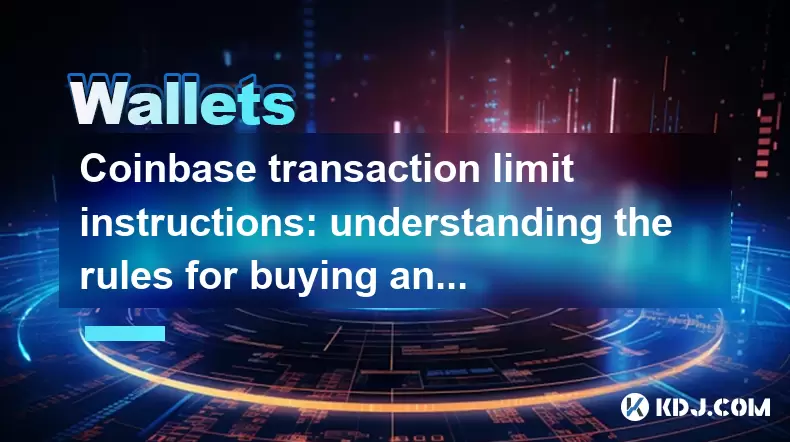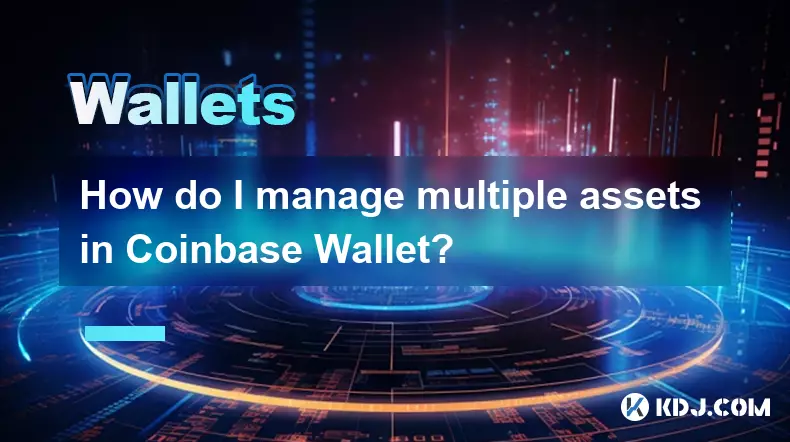-
 bitcoin
bitcoin $109523.663807 USD
-0.13% -
 ethereum
ethereum $4019.526508 USD
2.06% -
 tether
tether $1.000482 USD
0.00% -
 xrp
xrp $2.776815 USD
0.18% -
 bnb
bnb $958.942396 USD
0.12% -
 solana
solana $204.294698 USD
3.84% -
 usd-coin
usd-coin $0.999693 USD
0.00% -
 dogecoin
dogecoin $0.232115 USD
2.09% -
 tron
tron $0.338028 USD
0.84% -
 cardano
cardano $0.790920 USD
1.50% -
 hyperliquid
hyperliquid $44.871443 USD
5.60% -
 ethena-usde
ethena-usde $1.000322 USD
0.04% -
 chainlink
chainlink $21.034165 USD
2.60% -
 avalanche
avalanche $28.794831 USD
-0.54% -
 stellar
stellar $0.360466 USD
1.24%
Coinbase Transaction Limite Instructions: Comprendre les règles d'achat et de vente de limites
Coinbase sets transaction limits based on verification level, account history, and location to comply with regulations and prevent fraud.
Jul 08, 2025 at 09:50 am

Quelle est la limite de transaction Coinbase?
La limite de transaction Coinbase fait référence au montant maximal de la crypto-monnaie ou de la monnaie fiduciaire qu'un utilisateur peut acheter, vendre, envoyer ou recevoir dans un délai spécifié sur la plate-forme Coinbase. Ces limites sont en place pour garantir la conformité aux exigences réglementaires et pour prévenir les activités frauduleuses. Les limites exactes varient en fonction de facteurs tels que le niveau de vérification des utilisateurs , l'historique des comptes et la localisation géographique .
Les utilisateurs qui ont terminé la vérification de base de l'identité sont généralement confrontés à des limites inférieures par rapport à ceux qui ont suivi des processus de vérification avancés, comme la fourniture d'une pièce d'identité émise par le gouvernement et une preuve d'adresse.
Comment les limites de transaction Coinbase sont-elles déterminées?
Coinbase détermine les limites de transaction en fonction de plusieurs critères clés:
- Tier de vérification : Les utilisateurs de Coinbase se voient attribuer différents niveaux de vérification (niveau 0, niveau 1, niveau 2, etc.). Les niveaux plus élevés sont généralement livrés avec des limites de transaction quotidiennes et hebdomadaires augmentées .
- L'âge et l'activité du compte : les nouveaux comptes commencent souvent par de faibles limites qui augmentent avec le temps à mesure que le compte devient plus actif et fiable par le système.
- Méthode de paiement : Le type de mode de paiement utilisé (par exemple, transfert bancaire, carte de crédit, PayPal) affecte les limites. Par exemple, les achats de cartes de crédit ont souvent des limites inférieures à celles des transferts bancaires ACH.
- Emplacement : les environnements réglementaires diffèrent selon le pays. Les utilisateurs de régions avec des réglementations financières plus strictes peuvent subir des limites de défaut plus faibles .
Ces règles sont conçues pour s'aligner sur les lois sur la connaissance de votre client (KYC) et de lutte contre le blanchiment d'argent (AML) .
Limites de transaction quotidiennes vs hebdomadaires
Sur Coinbase, les limites sont généralement exprimées en quantités quotidiennes et hebdomadaires . Ceux-ci se réinitialisent à intervalles réguliers:
- Limites quotidiennes : Réinitialisez toutes les 24 heures. Par exemple, si vous avez une limite quotidienne de 5 000 $ pour l'achat de crypto, vous pouvez transformer jusqu'à ce montant chaque jour.
- Limites hebdomadaires : Réinitialisez une fois tous les sept jours. Si votre limite de vente hebdomadaire est de 20 000 $, vous ne pouvez pas dépasser ce total pendant la fenêtre roulante de sept jours.
Il est important de noter que ces limites s'appliquent à toutes les crypto-monnaies, sauf indication contraire. Par exemple, si vous êtes limité à 10 000 $ par semaine en échange de crypto, cela comprend Bitcoin, Ethereum et toutes les autres pièces prises en charge.
Comment vérifier vos limites de transaction actuelles sur Coinbase
Pour voir vos limites actuelles, suivez ces étapes:
- Connectez-vous à votre compte Coinbase .
- Cliquez sur l' icône de profil dans le coin supérieur droit.
- Accédez à la section Limites sous l'onglet Compte.
- Ici, vous verrez des informations détaillées concernant vos limites d'achat, de vente, d'envoi et de recevoir .
Si l'une des limites affichées sembler incorrectes ou obsolètes, cela peut être dû à des changements récents dans votre statut de vérification ou à des restrictions temporaires causées par des drapeaux d'activité suspects.
Comment augmenter vos limites de transaction Coinbase
L'augmentation des limites de transaction consiste à améliorer la fiabilité et le niveau de vérification de votre compte. Pour ce faire:
- Vérification complète de l'identité : Téléchargez une pièce d'identité émise par le gouvernement valide et confirmez votre adresse résidentielle.
- Lien d'un compte bancaire vérifié : Cela permet d'établir une légitimité financière et peut entraîner des limites plus élevées.
- Maintenir la stabilité des comptes : évitez les connexions fréquentes à partir de nouveaux appareils ou emplacements, ce qui peut déclencher des mesures de sécurité et réduire temporairement les limites.
- Assistance de contact : Dans certains cas, tendre la main au support client de Coinbase et demander un examen manuel peut entraîner une augmentation des limites, en particulier pour les commerçants à volume élevé ou les utilisateurs institutionnels.
Gardez à l'esprit que même après avoir terminé toutes les étapes de vérification, les limites ne peuvent toujours pas atteindre immédiatement les seuils les plus élevés possibles. Coinbase évalue le comportement du compte dynamiquement et peut ajuster les limites en conséquence.
Problèmes communs liés aux limites de transaction
Certains utilisateurs rencontrent des problèmes lorsque vous essayez d'exécuter de grandes transactions:
- Des baisses soudaines dans les limites : cela peut se produire après une activité de connexion inhabituelle ou s'il y a des vérifications en suspens.
- Les limites ne mettent pas à jour après la vérification : Parfois, le système peut prendre jusqu'à 24 à 48 heures pour refléter les limites mises à jour après la soumission des documents de vérification.
- Discances entre les limites d'achat et de vente : il est normal que les limites de vente soient plus élevées que les limites d'achat , selon votre source de financement et vos politiques régionales.
Si vous rencontrez des problèmes persistants, Coinbase recommande de revoir vos paramètres de sécurité , de confirmer votre documentation d'identité et de contacter leur équipe d'assistance pour obtenir de l'aide.
Questions fréquemment posées
Q: Puis-je contourner les limites de transaction Coinbase à l'aide de plusieurs comptes? R: Non, tenter de contourner les limites en créant des comptes supplémentaires viole les conditions d'utilisation de Coinbase et peut entraîner une suspension de compte ou des gel de fonds.
Q: Les limites de transaction s'appliquent-elles aux transactions crypto-à-crypto? R: Généralement, les métiers crypto-à-crypto ne sont pas soumis aux mêmes limites basées sur la fiat , mais elles peuvent toujours être surveillées pour une activité inhabituelle ou signalées pour examen.
Q: Pourquoi ma limite de transaction Coinbase a-t-elle diminué sans préavis? R: Les limites peuvent diminuer en raison des déclencheurs de sécurité , telles que la connexion à partir d'un nouvel appareil, le lancement de plusieurs retraits ou le non-respect de l'état vérifié.
Q: Les limites de transaction Coinbase sont-elles les mêmes dans le monde? R: Non, les limites varient considérablement en fonction de votre pays de résidence et des cadres réglementaires locaux. Certains pays peuvent également avoir des restrictions spécifiques sur certains types de transactions ou de crypto-monnaies.
Clause de non-responsabilité:info@kdj.com
Les informations fournies ne constituent pas des conseils commerciaux. kdj.com n’assume aucune responsabilité pour les investissements effectués sur la base des informations fournies dans cet article. Les crypto-monnaies sont très volatiles et il est fortement recommandé d’investir avec prudence après une recherche approfondie!
Si vous pensez que le contenu utilisé sur ce site Web porte atteinte à vos droits d’auteur, veuillez nous contacter immédiatement (info@kdj.com) et nous le supprimerons dans les plus brefs délais.
-
 APEX Échangez maintenant
APEX Échangez maintenant$2.17
173.41%
-
 ALPINE Échangez maintenant
ALPINE Échangez maintenant$5.35
161.08%
-
 OVPP Échangez maintenant
OVPP Échangez maintenant$0.09624
63.82%
-
 AIC Échangez maintenant
AIC Échangez maintenant$0.3359
41.17%
-
 H Échangez maintenant
H Échangez maintenant$0.06873
34.33%
-
 CARDS Échangez maintenant
CARDS Échangez maintenant$0.1868
33.79%
- Blockchainfx: La prévente de la cryptographie est amorcée pour une explosion de ROI en 2025
- 2025-09-27 18:25:19
- Vérification des prix ETH: L'argent intelligent reste cool au milieu des montagnes russes ATH
- 2025-09-27 18:25:19
- Aster Price, Mrbeast et Dex Volumes: quel est le buzz?
- 2025-09-27 18:45:11
- Shiba Inu, Coins Meme et Magacoin Finance: Quelle est la prochaine étape?
- 2025-09-27 18:45:11
- Aster Dex: Navigation de l'avenir de Defi avec les prévisions de prix et les informations clés
- 2025-09-27 18:50:01
- La nouvelle genèse du protocole Virtuals: une plongée profonde dans le lancement et le potentiel de $ virtual
- 2025-09-27 18:50:01
Connaissances connexes

Comment voir l'historique des interactions de contrats intelligents dans le portefeuille Coinbase?
Sep 24,2025 at 01:36am
Accéder à l'historique d'interaction des contrats intelligents dans le portefeuille Coinbase 1. Ouvrez l'application de portefeuille Coinb...

Comment utiliser la fonction d'échange de jetons dans le portefeuille Coinbase?
Sep 24,2025 at 05:00pm
Comprendre les échanges de jetons dans le portefeuille Coinbase 1. La fonction d'échange de jetons dans Coinbase Wallet permet aux utilisateurs d&...

Comment participer au vote de gouvernance au portefeuille Coinbase?
Sep 25,2025 at 01:55pm
Comprendre la volatilité du marché dans l'espace cryptographique 1. Les marchés des crypto-monnaies sont connus pour leurs fluctuations de prix ex...

Comment configurer un nœud RPC personnalisé dans le portefeuille Coinbase?
Sep 24,2025 at 12:00pm
Comprendre les nœuds RPC personnalisés dans le portefeuille Coinbase 1. Un nœud RPC (appel de procédure distant) personnalisé permet aux utilisateurs ...

Comment gérer plusieurs actifs dans le portefeuille Coinbase?
Sep 23,2025 at 10:00am
Comprendre le support multi-réseaux dans le portefeuille Coinbase 1. Le portefeuille Coinbase permet aux utilisateurs de stocker une grande variété d&...

Comment connecter le portefeuille Coinbase à un portefeuille matériel?
Sep 26,2025 at 02:54am
Connexion du portefeuille Coinbase à un périphérique matériel 1. Ouvrez l'application Coinbase Wallet sur votre appareil mobile et assurez-vous qu...

Comment voir l'historique des interactions de contrats intelligents dans le portefeuille Coinbase?
Sep 24,2025 at 01:36am
Accéder à l'historique d'interaction des contrats intelligents dans le portefeuille Coinbase 1. Ouvrez l'application de portefeuille Coinb...

Comment utiliser la fonction d'échange de jetons dans le portefeuille Coinbase?
Sep 24,2025 at 05:00pm
Comprendre les échanges de jetons dans le portefeuille Coinbase 1. La fonction d'échange de jetons dans Coinbase Wallet permet aux utilisateurs d&...

Comment participer au vote de gouvernance au portefeuille Coinbase?
Sep 25,2025 at 01:55pm
Comprendre la volatilité du marché dans l'espace cryptographique 1. Les marchés des crypto-monnaies sont connus pour leurs fluctuations de prix ex...

Comment configurer un nœud RPC personnalisé dans le portefeuille Coinbase?
Sep 24,2025 at 12:00pm
Comprendre les nœuds RPC personnalisés dans le portefeuille Coinbase 1. Un nœud RPC (appel de procédure distant) personnalisé permet aux utilisateurs ...

Comment gérer plusieurs actifs dans le portefeuille Coinbase?
Sep 23,2025 at 10:00am
Comprendre le support multi-réseaux dans le portefeuille Coinbase 1. Le portefeuille Coinbase permet aux utilisateurs de stocker une grande variété d&...

Comment connecter le portefeuille Coinbase à un portefeuille matériel?
Sep 26,2025 at 02:54am
Connexion du portefeuille Coinbase à un périphérique matériel 1. Ouvrez l'application Coinbase Wallet sur votre appareil mobile et assurez-vous qu...
Voir tous les articles









































































